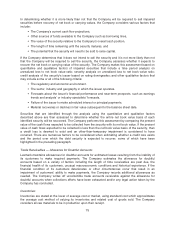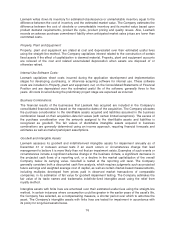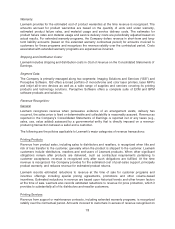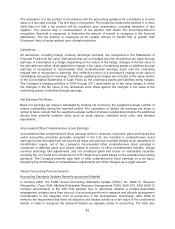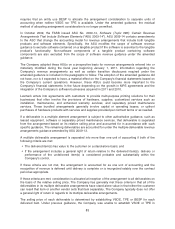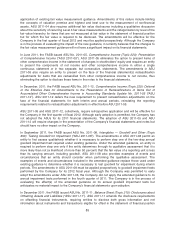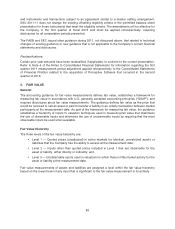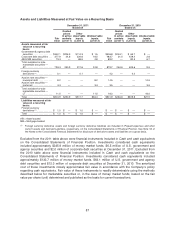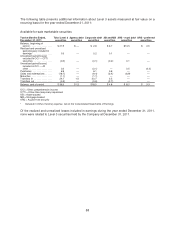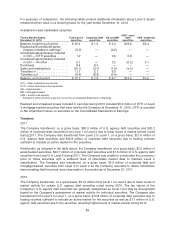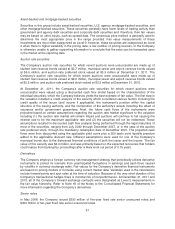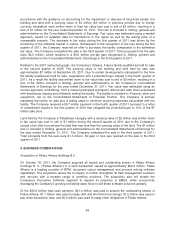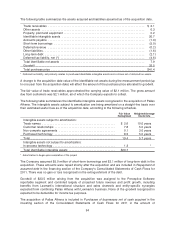Lexmark 2011 Annual Report Download - page 88
Download and view the complete annual report
Please find page 88 of the 2011 Lexmark annual report below. You can navigate through the pages in the report by either clicking on the pages listed below, or by using the keyword search tool below to find specific information within the annual report.
regards to certain equipment deliverables, thus consideration was allocated using the residual method.
Under the new guidance, if VSOE or TPE is not determinable, the Company utilizes its best estimate of
selling price in order to allocate consideration for those deliverables.
The Company uses its best estimate of selling price when allocating the transaction price for most of its
deliverables. Best estimate of selling price for the Company’s product deliverables is determined by
utilizing a weighted average price approach. Best estimate of selling price for the Company’s service
deliverables is determined by utilizing a cost plus margin approach. These approaches are described
further in the paragraphs below.
The Company’s method for determining management’s best estimate of selling price for products starts
with a review of historical standalone sales data. Prior sales are grouped by product and key data
points utilized such as the average unit price and the weighted average price in order to incorporate
the frequency of each product sold at any given price. Due to the large number of product offerings,
products are then grouped into common product categories (families) incorporating similarities in
function and use and a BESP discount is determined by common product category. This discount is
then applied to product list price to arrive at a product BESP. This method is performed and applied at
a geography level in order to incorporate variances in product pricing across worldwide boundaries.
The Company does not typically sell its services on a standalone basis, thus a best estimate of selling
price for services is determined using a cost plus margin approach. The Company typically uses third
party suppliers to provide the services component of its multiple element arrangements, thus the cost
of services is that which is invoiced to the Company. A margin is applied to the cost of services in order
to determine a best estimate of selling price, and is primarily determined by considering third party
prices of similar services to consumers and geographic factors. In the absence of third party data the
Company considers other factors such as historical margins and margins on similar deals as well as
cost drivers that could affect future margins.
For multiple deliverable arrangements that involve capital leases or the upfront purchase of hardware
equipment, the use of best estimate of selling price could result in the Company recognizing a larger
portion of revenue earlier in the contract life when compared to using the residual method under prior
guidance. This difference in the timing of revenue recognition did not have a material impact to the
Company’s 2011 consolidated financial statements and is not expected to materially impact the
Company’s financial statements for new or materially modified arrangements. Additionally, there will be
little to no effect on the timing of revenue recognition from the use of a best estimate of selling price for
operating leases or for the services and supplies components of multiple deliverable arrangements as
revenue for deliverables in these arrangements is recognized ratably or as services are performed.
With respect to the new software guidance, the modification did not result in a change in the amounts
or timing of revenue recognition for the Company’s multiple deliverable arrangements that contain
software components. Software included within the equipment component that was considered
incidental under the previous guidance will continue to be accounted for as part of the sale of the
equipment under the amended guidance. Software that is not considered incidental and does not
function together with the non-software components to deliver the equipment’s essential functionality
will continue to be accounted for under the industry-specific software revenue recognition guidance.
The residual method of allocating arrangement consideration is still permitted under the industry-
specific software revenue recognition guidance.
Accounting Standards Updates Recently Issued But Not Yet Effective
In May 2011, the FASB issued ASU No. 2011-04, Fair Value Measurement (Topic 820): Amendments
to Achieve Common Fair Value Measurement and Disclosure Requirements in U.S. GAAP and IFRSs
(“ASU 2011-04”). ASU 2011-04 changes certain fair value measurement principles and clarifies the
84



